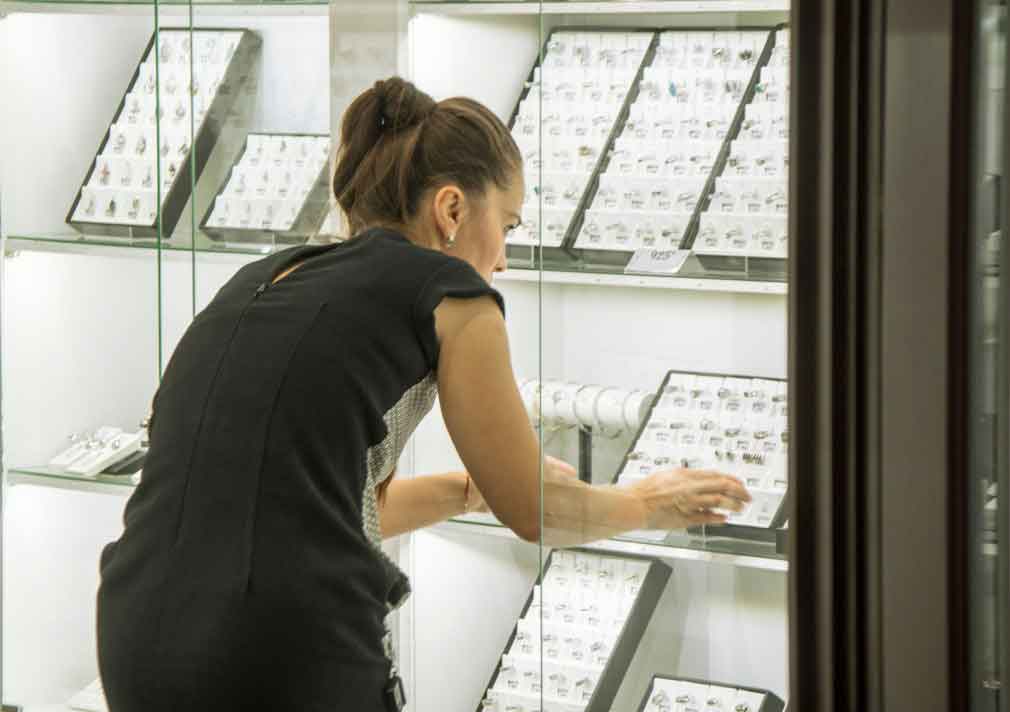The jewelry industry is huge, not only in the United States, but across the global market as well. Prior to the worldwide COVID-19 outbreak, Grand View Research estimated the jewelry industry to reach $480.5 billion by 2025. With retailers closed for many months due to the pandemic, that market size may drop slightly. Still, predictions of greater disposable income and trends in customer preferences indicate the jewelry industry can expect strong market growth.
When jewelry stores and businesses are looking toward the future, they should consider a few prominent trends when formulating marketing strategies and determining the best ways to provide the products and services that cater to their consumers. We’ve outlined five major trends shaping the jewelry industry and market outlook and how stores can utilize these trends to serve their shoppers best.
1. Personalization
From bracelets to engagement and wedding rings—essentially any piece of jewelry—retailers are seeing a huge trend toward customization. If a buyer is going to invest in jewelry, whether for themselves or for someone they love, they want the piece to make a statement.
We see customization in every level of the jewelry industry, from daily wear brands to fine jewelry stores. Finding an artist who can engrave a name or date into a bangle is effortless. And for customers wanting a more boutique experience, personalization of bracelets, earrings, and rings has come to be expected in many high-end establishments.
This trend toward customization and personalization reverberates throughout the jewelry market. As people are wanting custom pieces, stores—both brick and mortar and eCommerce stores—are providing this option. Catering to customers who want custom pieces allows jewelry stores to serve a wider range of customers and increase the amount of inventory they move month after month.
2. Higher Value on Ethical Sourcing
Now more than ever, consumers care about where their jewelry comes from—and, perhaps just as important, who it comes from. Buyers and companies alike are more aware of ethical jewelry production and purchase value. After all, ethical jewelry practices have social and environmental benefits, protecting both workers and the earth that the source materials are from.
Even though ethical sourcing and production is ideal, it isn’t easy. From working conditions to fair wages to mining practices—there are so many variables that must be controlled in order for a piece of jewelry to earn the “ethically sourced” stamp. And that’s just the sourcing stage of jewelry production.
Ethical and sustainable jewelry is extremely popular. At the same time, it’s expensive to source and produce. However, there continues to be a demand for jewelry that is sustainably created. Consumers feel good about jewelry that does good. As long as there is a demand, there will be a supply.
3. Less Spending on Engagement Rings
You’re probably familiar with the “three-month salary” rule of engagement ring budgeting. It has been customary that an engagement ring should cost one-quarter of the buyer’s yearly salary. That can make for a big, beautiful ring. But it can also put a lot of financial pressure and distress on the buyer.
These days, those in love and looking to marry are throwing the “three month’s salary” rule out of the window. According to a 2019 study by The Knot, one-third of those surveyed spent between $1,000 and $3,000 on an engagement ring. Furthermore, ten percent of respondents noted spending less than $1,000 on a ring.
The study did note that the national average was $5,900, with some regions boasting higher averages than others. However, the jewelry industry cannot ignore the incredible percentage of shoppers spending $3,000 or less on an engagement ring.
In many relationships, an engagement ring will be the largest jewelry investment a partner makes. With so many hopefuls purchasing engagement rings at comparably low prices, jewelry companies will need to rethink the inventory they carry and how consumer spending habits, in regard to engagement rings, will affect their business models.
4. Social Media Shopping
Social media is another way that jewelry stores can reach potential customers and get their products directly in front of their target audience. Perhaps the most beneficial social media app for jewelers and shoppers is Instagram.
A couple of years ago, Instagram debuted a shopping feature. This enables businesses to effectively showcase their products and designs to a limitless array of customers all across the globe. Businesses simply tag their products in their pictures like they would tag a person’s account. When a user visits a business’s Instagram account, they can scroll through posts, then tap on an item they are interested in. The feature will show the item’s price, and if they want to see more details about the piece, they can double-tap, which then links to the company’s site where they can easily make a purchase.
This innovative shopping experience makes browsing for and purchasing jewelry more actionable and less transactional and less intimidating. Ultimately, it’s marketing that benefits the business because of its low cost and huge reach and the consumer because it gives them easy access to jewelry on a platform that they’re comfortable with and enjoys using.
5. Financing
One of the most beneficial trends in the jewelry industry is financing. When a jewelry business offers to finance for their customers, the shopper doesn’t have to postpone a purchase due to a lack of immediately available funds—an especially important consideration if someone is shopping for an engagement ring! So often, jewelry symbolizes love, gratitude, and celebration. Financing options allow customers to give symbolic gifts—or buy something special for themselves—without waiting.
With financing programs from United Consumer Financial Services, jewelers and jewelry businesses can give customers an approval status in minutes. Customers can choose a monthly payment plan that fits their budget without interfering with daily, weekly, or monthly expenses. By providing financing options, jewelers allow their customers to bring home their piece of jewelry the same day. In the case of engagement ring purchases, this means new couples can begin their lives together sooner rather than later!
